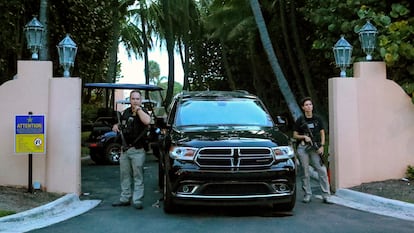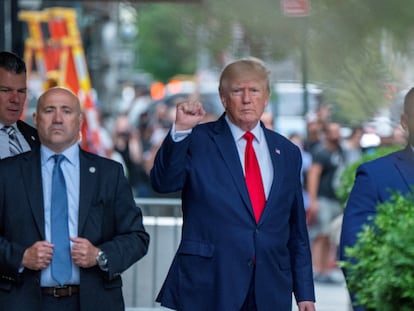Donald Trump’s search statement has been released, but most of it is blacked out
The affidavit states that the documents could put intelligence sources at risk


The statement that served to justify the search of Mar-a-Lago, Donald Trump’s mansion in Florida, has been made public. However, the released version has practically half of its contents blacked out. Although the affidavit mentions evidence of the former president’s crimes, none of the sources, nor the concrete evidence, was revealed. There are only a few new notes, including that the FBI feared that Trump’s withholding of the documents endangered the identity of an intelligence source.
The statement is signed by an FBI special agent whose identity was not disclosed. Allusions to the course of the investigation have also been crossed out. The origin of the case is reconstructed, with the efforts of the National Archives to make Trump return the documentation, first, and then the surprise that when he did deliver the boxes there were 184 classified documents in them. Of those, 67 documents were marked as confidential, 92 as secret and 25 as top secret.
The FBI had evidence that Trump kept more classified documents at Mar-a-Lago, which is why it requested the search warrant. However, most of it, apparently including some photographs, is blacked out in the document made public this Friday. The statement explains that the FBI investigation established that documents with classification marks, which appear to contain National Defense information, were among the materials contained in the 15 boxes (delivered last January after repeated requests) and were stored in an unauthorized place in Mar-a-Lago.
“There is probable cause to believe that additional documents that contain classified NDI or that are Presidential records subject to record retention requirements currently remain at the premises. There is also probable cause to believe that evidence of obstruction will be found,” adds the special agent who signs the affidavit.
The disclosure of the inventory of seized assets already made it possible to know that the FBI was right. Eleven sets of classified documents were found, including many top secret and some with the acronym TS/SCI, (Top Secret/Sensitive Compartmented Information).
Among the documentation published this Friday there is also a letter from Trump’s lawyers dated May 25 and addressed to the Department of Justice, which states that a president has absolute authority to declassify documents. Two weeks ago, Trump said that he had declassified all those documents, but without providing any documentary justification for it.
The criminal law articles for which Trump is being investigated do not require in the definition of the crime that the documentation be classified as such, but it is enough if it could harm national security. After reviewing the different classifications of the returned documents and of those that could still remain at Mar-a-Lago (which are not disclosed), the special agent who signs the report states: “Based on my training and experience, I know that documents classified at these levels typically contain National Defense Information [NDI].”
In the affidavit, the legal definitions and background are mostly known. However, most of the information about the investigation is hidden. A section entitled “There is probable cause to believe that documents containing classified NDI and presidential records remain at the premises” is almost completely crossed out.
Trump’s reaction
The fact that a large part of the document is censored takes away its strength. Trump plays with that advantage, and has reacted to the publication of the statement with a message on his social network: “Affidavit heavily redacted!!! Nothing mentioned on ‘Nuclear,’ a total public relations subterfuge by the FBI & DOJ, or our close working relationship regarding document turnover - WE GAVE THEM MUCH. Judge Bruce Reinhart should NEVER have allowed the Break-In of my home. He recused himself two months ago from one of my cases based on his animosity and hatred of your favorite President, me. What changed? Why hasn’t he recused himself on this case? Obama must be very proud of him right now!” he wrote.
These kinds of statements are not published when a case is still in progress. The Department of Justice argued that its dissemination could compromise the investigation, and that if the document was only partially published it would be incomprehensible and meaningless. The omissions necessary to mitigate the damage to the integrity of the investigation, it stated last week, would be so extensive that the remaining text would have no meaningful content.
Federal judge Bruce E. Reinhart, however, decided that it should be published, accepting that substantial parts be withheld. Whether or not what remains is of public interest, relevant and significant, is not up to him to say, he argued at a hearing held last Thursday in the South Florida court that he presides. On Thursday, the Department of Justice delivered the non-confidential version. After receiving it, Judge Reinhart, who had authorized the search warrant, approved the proposed cross-outs and decided that the document should be published this Friday.
Both the District Attorney’s Office and Trump agreed to publish the search warrant with its annexes and the inventory of assets seized by agents of the FBI. This revealed that Trump is being investigated for at least three possible crimes punishable by fines
and/or long prison sentences, and also that numerous documents classified as “top secret” were found in the registry. Trump later claimed that he had declassified those documents, but there is no documentary evidence of it
Tu suscripción se está usando en otro dispositivo
¿Quieres añadir otro usuario a tu suscripción?
Si continúas leyendo en este dispositivo, no se podrá leer en el otro.
FlechaTu suscripción se está usando en otro dispositivo y solo puedes acceder a EL PAÍS desde un dispositivo a la vez.
Si quieres compartir tu cuenta, cambia tu suscripción a la modalidad Premium, así podrás añadir otro usuario. Cada uno accederá con su propia cuenta de email, lo que os permitirá personalizar vuestra experiencia en EL PAÍS.
¿Tienes una suscripción de empresa? Accede aquí para contratar más cuentas.
En el caso de no saber quién está usando tu cuenta, te recomendamos cambiar tu contraseña aquí.
Si decides continuar compartiendo tu cuenta, este mensaje se mostrará en tu dispositivo y en el de la otra persona que está usando tu cuenta de forma indefinida, afectando a tu experiencia de lectura. Puedes consultar aquí los términos y condiciones de la suscripción digital.
More information
Archived In
Últimas noticias
Maude Apatow, from acting in ‘Euphoria’ to directing: ‘There are many films that you can tell weren’t written by someone young’
The life of a delivery driver in China: ‘Many people don’t know how an order can arrive at their home in just one day’
Mexico’s missing people crisis casts a shadow over World Cup venue
The guardians of the meteorites of the Argentine Chaco
Most viewed
- Christian Louboutin: ‘Young people don’t want to be like their parents. And if their parents wear sneakers, they’re going to look for something else’
- US sanctions against jailed cartel leader ‘El Marro’ highlight Mexico’s lack of control over its prisons
- Cartels in Mexico take a leap forward with narco-drones: ‘It is criminal groups that are leading the innovation race’
- Liset Menéndez de la Prida, neuroscientist: ‘It’s not normal to constantly seek pleasure; it’s important to be bored, to be calm’
- ‘El Limones’ and the growing union disguise of Mexican organized crime










































